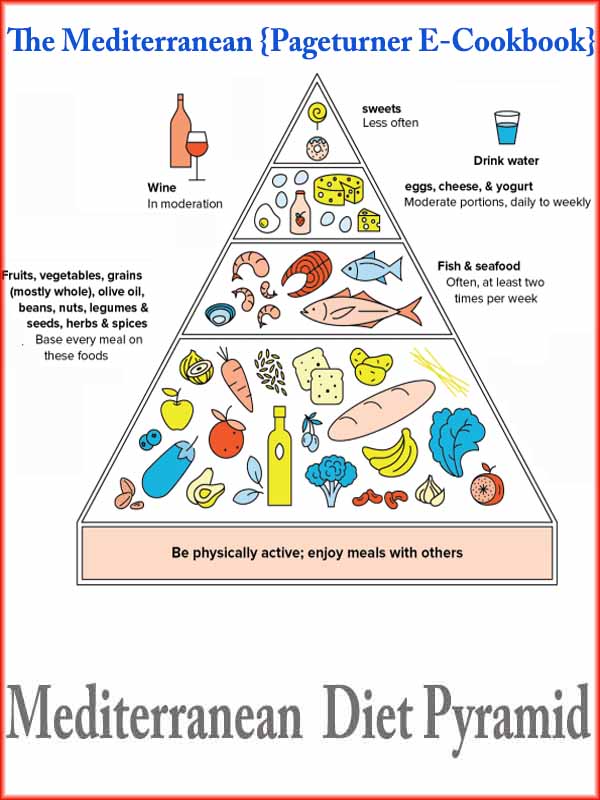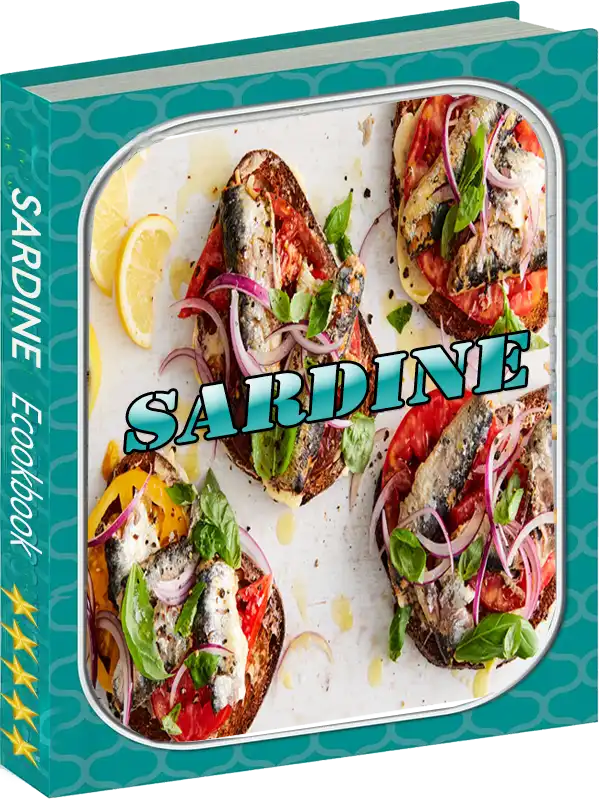If you love all things sardine
this {Pageturner Ecookbook} is for you
SARDINES
If there’s ever been a fish that’s purely made for a barbecue, it’s sardines. It is a highly versatile fish. Nutritious, inexpensive, safe, and sustainable are these tasty tiny morsels. The high oil concentration and robust taste of sardines are perfect for marinated/raw procedures, alongside pan-frying and barbeque.
Sardines are a favorite among dietitians for many reasons: They are high in protein, nutrient-dense and low in mercury making them the healthiest fish on our plates.
Rich in omega-3 fatty acids, proteins and minerals such as calcium, phosphorus and iron, sardines are also an excellent source of vitamins B3, B12 and D. They also promote cardiovascular and brain health.
One serving or can of the average store-bought sardines packed in oil provides about:
200 calories
22 grams of protein
12 grams of fat
200-300 milligrams of sodium
"Sardines are an excellent source of protein.
The small, nutrient-dense fish are also packed with omega-3 fatty acids, a type of polyunsaturated fat that can help support heart, brain, skin and immune health. Foods high in omega-3s can help increase good (HDL) cholesterol and can lower bad (LDL) cholesterol. Sardines are also packed with vitamin D, vitamin B12, calcium, phosphorus and selenium. They are also a good source of potassium, iron, zinc and choline. Sardines are one of the lowest-mercury fish you can buy. They’re considered a “best choice” fish by the FDA, and are safe to eat in moderation for pregnant women and children. Sardines can be enjoyed straight from the can with crackers, on top of a bed of salad or rice, or in pasta sauces. Mediterranean Tradition: Grilled Sardines Around the World Grilled sardines are deeply rooted in Mediterranean culinary traditions. Here’s how they are enjoyed in different countries: Spain: “Espetos” – The Ultimate Beachside Treat In Spain, particularly in Andalusia, sardines are skewered on long bamboo sticks and grilled over open wood fires. This method, called “espetos”, creates a smoky, charred flavor that pairs beautifully with a squeeze of lemon. Portugal: “Sardinhas Assadas” – A National Dish Portuguese grilled sardines, or “sardinhas assadas”, are a highlight of Lisbon’s famous Santo António Festival. The fish are seasoned with coarse salt and grilled to perfection, served with peppers and potatoes. Greece & Italy: Lemon, Olive Oil & Herbs In Greece and Italy, grilled sardines are often marinated in lemon, olive oil, and fresh herbs like oregano and parsley before hitting the grill. The result? A fresh, vibrant dish that captures the essence of Mediterranean cuisine. Brisling sardines, known for their delicate flavor and high nutritional value, are small fish primarily found in the North Atlantic, making them a premium choice among sardines. What Are Brisling Sardines? Brisling sardines, scientifically known as Sprattus sprattus, are small fish that typically measure between 3 to 5 inches in length. They are characterized by their slender bodies, shimmering silver scales, and a rich, savory taste. These sardines are often considered the highest quality among sardine varieties due to their delicate texture and flavor.
22 grams of protein
12 grams of fat
200-300 milligrams of sodium
"Sardines are an excellent source of protein.
The small, nutrient-dense fish are also packed with omega-3 fatty acids, a type of polyunsaturated fat that can help support heart, brain, skin and immune health. Foods high in omega-3s can help increase good (HDL) cholesterol and can lower bad (LDL) cholesterol. Sardines are also packed with vitamin D, vitamin B12, calcium, phosphorus and selenium. They are also a good source of potassium, iron, zinc and choline. Sardines are one of the lowest-mercury fish you can buy. They’re considered a “best choice” fish by the FDA, and are safe to eat in moderation for pregnant women and children. Sardines can be enjoyed straight from the can with crackers, on top of a bed of salad or rice, or in pasta sauces. Mediterranean Tradition: Grilled Sardines Around the World Grilled sardines are deeply rooted in Mediterranean culinary traditions. Here’s how they are enjoyed in different countries: Spain: “Espetos” – The Ultimate Beachside Treat In Spain, particularly in Andalusia, sardines are skewered on long bamboo sticks and grilled over open wood fires. This method, called “espetos”, creates a smoky, charred flavor that pairs beautifully with a squeeze of lemon. Portugal: “Sardinhas Assadas” – A National Dish Portuguese grilled sardines, or “sardinhas assadas”, are a highlight of Lisbon’s famous Santo António Festival. The fish are seasoned with coarse salt and grilled to perfection, served with peppers and potatoes. Greece & Italy: Lemon, Olive Oil & Herbs In Greece and Italy, grilled sardines are often marinated in lemon, olive oil, and fresh herbs like oregano and parsley before hitting the grill. The result? A fresh, vibrant dish that captures the essence of Mediterranean cuisine. Brisling sardines, known for their delicate flavor and high nutritional value, are small fish primarily found in the North Atlantic, making them a premium choice among sardines. What Are Brisling Sardines? Brisling sardines, scientifically known as Sprattus sprattus, are small fish that typically measure between 3 to 5 inches in length. They are characterized by their slender bodies, shimmering silver scales, and a rich, savory taste. These sardines are often considered the highest quality among sardine varieties due to their delicate texture and flavor.
Grilled sardines 

Serves: 2
Preparation time:15 minutes
Cooking time:10 minutes
600 grams (1.3 pound) whole fresh sardines
3 tablespoons olive oil
⅔ teaspoon kosher salt
dried oregano to serve with
lemon quarters to serve with
For The Lemon Dressing:
4 tablespoons extra virgin olive oil
3 tablespoons lemon juice Prepare The Sardines:
Place the sardines in a bowl with very cold water. And allow them to soak for 20 minutes. This will help firm their skin so it won't break as you clean them.
Rub the skin to remove any scales.
Gut the sardines by making a small incision with a knife on the belly right after the head.Pull out the innards.
Rinse the sardines well.
Prepare The Lemon Dressing:
Add the extra virgin olive oil and lemon juice to a small bowl and whisk until it thickens.e one.
Grill The Sardines:
Heat a grill pan, griddle, or bbq on high. Brush the grates with oil.
Pat dry the sardines. Then drizzle with the 3 tablespoons of olive oil and sprinkle the salt on top. Gently mix so the oil and salt spread all over.
The cooking surface must be very hot so that the fish won't stick. If cooking on a bbq you may need to adjust the heat to medium. Sardines tend to flame up due to their fat content.
Cook the sardines for 2 minutes on high or 5-6 minutes on medium before flipping them.
Flip the sardines carefully.
Cook for 3 more minutes on high or 6-7 minutes on medium.
Add sardines to a plate, and pour the emulsified dressing all over the fish. Sprinkle some dried oregano on top and serve with a few pieces of lemon on the side.
Grilled sardines with green herbs 

Serves: 2
Preparation time:10 minutes
Cooking time:8 minutes
scorch.
1 tsp finely grated lemon zest
½ tbsp finely chopped rosemary
1 tbsp finely chopped parsley
1 garlic clove, very finely chopped
½ tbsp finely chopped pitted green olives
½ tbsp chopped capers
½ tsp sea salt flakes
¼ tsp freshly ground black pepper
8 large sardines, cleaned and trimmed
Extra virgin olive oil, for brushing and serving
Lemon wedges, to serve Mix together the lemon zest, rosemary, parsley, garlic, olives, capers, salt and pepper. Set aside. Preheat the grill to high.
Pierce each sardine from head to tail with a skewer. Lay them on a lightly oiled baking tray and sprinkle them with some extra virgin olive oil, salt and pepper. Grill for 2 minutes on each side.
Serve the skewered sardines scattered with the herb mixture, drizzled with a little extra oil and with the lemon wedges alongside.
Mini Sardine croquettes 

Serves: 8
Preparation time:10 minutes
Cooking time:10 minutes
½ cup plain whole milk yogurt
½ cup Panko breadcrumbs
2 twigs fresh thyme
2 teaspoons Old Bay seasoning
1 egg
For the Spicy Yogurt Sauce:
1/2 cup plain whole milk yogurt
1 tablespoon Dijon mustard
1 tablespoon capers
1 tablespoon wine vinegar
1 teaspoon Worcestershire sauce
⅛ teaspoon cayenne powder, to taste (optional)
pinch salt, to taste Remove sardines from tin, reserving oil, and place fish in a mixing bowl. Add remaining fish cake ingredients, along with the oil from one tin about 2 tablespoons to the bowl.
Gently mix all the ingredients together with a fork.
Use a tablespoon measuring spoon and scoop the fish cake mix into small balls.
Roll the balls in your hands, and then flatten into small patties 2 inch across, and about 1/2 inch thick. Makes about 16 patties.
Set patties on a rimmed baking sheet, large cast iron pan, or casserole dish.
Refrigerate patties for about 30 minutes.
While fish cakes chill, mix together all the ingredients for the yogurt sauce. Make sure to taste as you add the cayenne and salt-- use more or less as desired. Put sauce in the refrigerator until it's time to serve.
Broil fish cakes 5 minutes near the heat source, flip, and broil 3-5 minutes more, until fish cakes are golden.
Remove cakes from pan and serve while still hot with the yogurt sauce.
Note: To freeze, store the mini cakes in an air-tight container in the freezer, and use within three months. To reheat, simply unwrap and cook until golden.
Sardine pâté 

Serves: 4
Preparation time:15 minutes
1/2 teaspoon of mustard
1 oz of chopped dill pickles
1 (5-oz) can of sardines in olive oil
1/2 cup red onion, finely chopped
1 small tomato, peeled, seeded and diced
2 tablespoons of olive oil
1 tablespoon lemon juice
salt (to taste)
2 teaspoons Worcestershire sauce (optional)
Combine the onion, tomato and pickle into a mixing bowl. Set aside. Drain and save the liquid from the can of sardines. Mash sardines with a fork. Set aside.
Put the mayonnaise, lemon drops and olive oil in a bowl. Mix lightly with a fork until smooth.
Add the two reserved parts and mix with a fork.
Add a few drops of Worcestershire sauce (optional). Season with salt to taste. Mix again.
As an optional presentation, simply place in a smaller bowl and serve with toast.
As a starter, place the rim of a pastry cutter on the plate and put the pâté inside. Press with a spoon and remove the ring.
Sardines with confit thyme tomatoes 

Serves: 4
Preparation time:10 minutes
Cooking time:12 minutes
Olive oil
8 garlic cloves, peeled and roughly chopped
A few sprigs of thyme, finely chopped
1 teaspoon balsamic vinegar
2 tins of sardines in olive oil (120g each), drained
Sea salt and freshly ground black pepper Cut the cherry tomatoes in half and remove the seeds.
Heat the olive oil in a large frying pan and place the tomatoes, cut-side down, into the pan. Add the garlic and a little thyme. Turn down the heat and leave the tomatoes to slowly absorb the flavours.
Once the skins are shrivelled and the cut side has colored slightly, remove the pan from the heat and leave the tomatoes to cool.
Gently remove the skins from the tomatoes. This should be easy if the tomatoes are completely cooked. Crush the tomatoes with the garlic and olive oil. Season with the vinegar, salt and pepper.
Spoon the tomatoes on to plates, top with sardines and sprinkle with a little more thyme, if you like.
conversion of liquids
Weights
Temperatures
Measures of non liquid ingredients
Non-liquid ingredients in volume converted
|
|||||||
|---|---|---|---|---|---|---|---|
Ingredient |
1 cup |
3/4 cup |
2/3 cup |
1/2 cup |
1/3 cup |
1/4 cup |
2 tablespoons |
| All-purpose wheat flour | 120 g | 90 g | 80 g | 60 g | 40 g | 30 g | 15 g |
| All-purpose sifted wheat flour | 110 g | 80 g | 70 g | 55 g | 35 g | 27 g | 13 g |
| White sugar | 200 g | 150 g | 130 g | 100 g | 65 g | 50 g | 25 g |
| Powdered sugar/Icing sugar | 100 g | 75 g | 70 g | 50 g | 35 g | 25 g | 13 g |
| Brown sugar normally packed | 180 g | 135 g | 120 g | 90 g | 60 g | 45 g | 23 g |
| Corn flour | 160 g | 120 g | 100 g | 80 g | 50 g | 40 g | 20 g |
| Cornstarch | 120 g | 90 g | 80 g | 60 g | 40 g | 30 g | 15 g |
| Rice (not-cooked) | 190 g | 140 g | 125 g | 95 g | 65 g | 48 g | 24 g |
| Macaroni (uncooked) | 140 g | 100 g | 90 g | 70 g | 45 g | 35 g | 17 g |
| Couscous (uncooked) | 180 g | 135 g | 120 g | 90 g | 60 g | 45 g | 22 g |
| Quick oatmeal (uncooked) | 90 g | 65 g | 60 g | 45 g | 30 g | 22 g | 11 g |
| Table salt | 300 g | 230 g | 200 g | 150 g | 100 g | 75 g | 40 g |
| Butter / Margarine | 240 g | 180 g | 160 g | 120 g | 80 g | 60 g | 30 g |
| Shortening | 190 g | 140 g | 125 g | 95 g | 65 g | 48 g | 24 g |
| Fruits and légumes chopped | 150 g | 110 g | 100 g | 75 g | 50 g | 40 g | 20 g |
| chopped walnuts | 150 g | 110 g | 100 g | 75 g | 50 g | 40 g | 20 g |
| Nuts /ground almonds | 120 g | 90 g | 80 g | 60 g | 40 g | 30 g | 15 g |
| Fresh bread crumbs (not packed) | 60 g | 45 g | 40 g | 30 g | 20 g | 15 g | 8 g |
| Dry bread crumbs | 150 g | 110 g | 100 g | 75 g | 50 g | 40 g | 20 g |
| Parmesan grated | 90 g | 65 g | 60 g | 45 g | 30 g | 22 g | 11 g |
| Chocolate chips | 150 g | 110 g | 100 g | 75 g | 50 g | 38 g | 19 g |

Last page
sardine
{Page-Turner} E-Cookbooks Library
on a world cooking journey.
5 Recipes
sardine recipes










